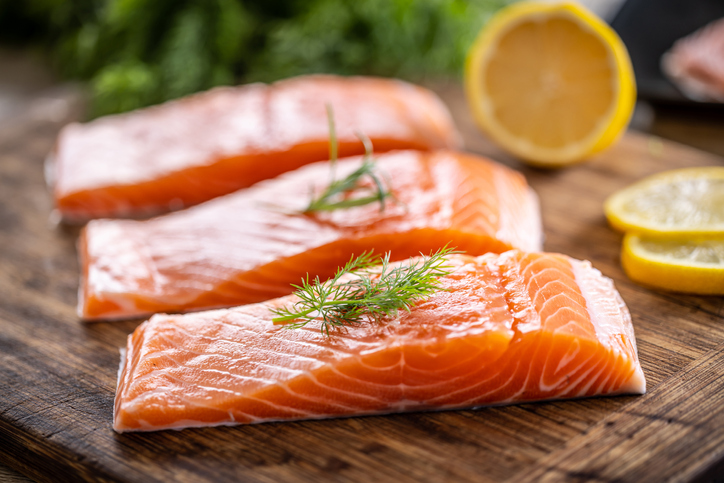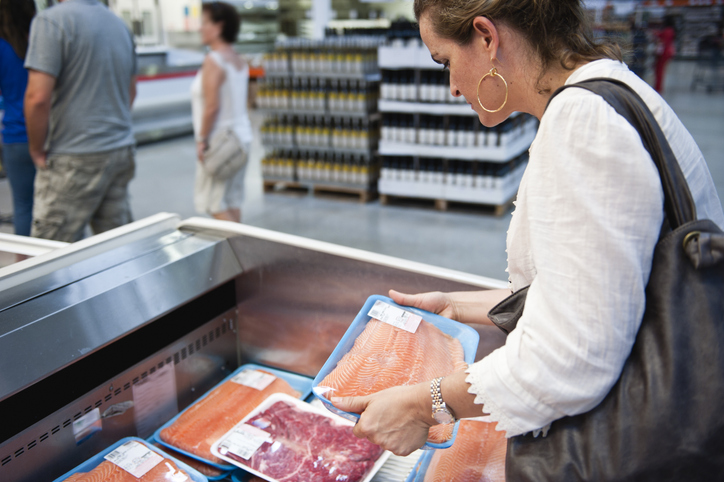A Guide to Eating Farmed Salmon

By Joy Stephenson-Laws, JD, Founder
When I first started writing this blog I felt like a bit of an imposter, because I try to only eat fish and seafood that is wild-caught. But the reality is that wild-caught is not always readily available or accessible to us all, so why not educate ourselves on how to find the best possible farmed fish and seafood?
Let’s start with salmon, the most popular fish in the United States.
According to the Global Salmon Initiative (GSI), 70 percent of salmon produced worldwide is farmed.
“In 2015 more than 2,200,000 tons of farmed salmon were produced, while in comparison around 880,000 tons of wild salmon were caught,” reported GSI.
Not all salmon are farmed the same.
There are different methods to farming salmon and other types of seafood. Let’s start with the most common and problematic method: open-net farming.
This method involves raising fish in enclosed nets or cages in offshore waters.
“Farmed salmon are bred to grow fast in cages so crammed that they are rife with parasites and disease. The fish eat pellets of fishmeal, vegetables, and animal byproducts; they are doused regularly with pesticides and antibiotics,” according to this article from Time Magazine, written by investigative journalists Douglas Frantz and Catherine Collins who wrote a book called Salmon Wars and spent more than two years investigating the global salmon farming business.
“As early as 2004, scientists found levels of polychlorinated biphenyls, a probable carcinogen known as PCBs, seven times higher in farmed Atlantic salmon than in wild salmon. More recent studies found high levels of other chemicals and antibiotics in farmed salmon.”
I could write an entirely separate blog about how this practice of salmon farming has an extremely negative impact on natural ecosystems and the environment. I was shocked to learn that these farmed salmon spend around two to three years in these open-net farms, and there can be as many as a million salmon “jammed into 10 or 12 cages,” according to the article from Time.
“The crowded cages are petri dishes for tiny parasites called sea lice and many viruses that kill farmed fish and endanger wild salmon when currents carry them outside the farms.”
Furthermore, “Massive doses of pesticides, including banned neurotoxins, and antibiotics are deployed against the parasites and pathogens. Some of the residue winds up in the salmon, and some falls to the seabed below the cages. Untreated waste from excess feed, decomposing fish, excrement, and chemical residue forms a toxic stew that kills or drives away marine life for hundreds of yards.”

Open-net salmon farming is so controversial and problematic that it’s even banned on the west coast of the United States.
How can we be proactive?Look for ASC-labeled seafood. ASC stands for Aquaculture Stewardship Council. The ASC is a major advocate for responsible seafood farming.
“ASC certified farms must ensure a cleaner seabed, cleaner water and healthier fish. They also preserve the diversity of the species and wild population, and adhere to strict feed requirements,” according to the ASC’s website.
“Feed must be sourced responsibly from sustainable, preferably certified sources, and minimize the use of wild fish as an ingredient in the feed. The ASC Feed Standard, launched in 2021, was developed to ensure salmon farmers – along with all other ASC certified farmers – source feed responsibly, and feed producers source ingredients sustainably.”
If you are a regular reader of my blogs, you know that it is important to read food labels in order to understand the ingredients we are putting in our bodies. This is really no different. We want to know where our seafood is coming so that we can get the best quality and healthiest option.
If you are unsure about the ASC label, ask your local fishmonger if he or she is providing sustainably certified farmed seafood. You can also look for the Best Aquaculture Practices (BAP) label.
Of course if you have wild-caught that is accessible to you, that is a great option. If you do not, the good news is that it appears you do not have to worry about receiving less of a nutritional bang for your buck.
According to the Global Salmon Initiative (GSI), “Both farmed and wild salmon have similar nutrient profiles, they are nutrient-dense, contributing high-quality protein, healthy fats like omega-3 fatty acids, and essential vitamins and minerals like potassium, vitamins D, B-12 and B-5 to the diet. Research from 2020 shows that farmed varieties can be better sources of omega-3 fatty acids than wild, but overall, the data shows there is no consistent difference in the health benefits of consuming either wild or farmed salmon.”
If you do eat fish and seafood, it is always good to know where it is coming from and consume in moderation. For invaluable information regarding consuming fish and seafood check out these pH Labs blogs:
- Why You Will Never See Tilapia On My Plate
- Is The Pescatarian Diet Safe?
- The News about Fish and Brain Health Just Keeps Getting Better
Enjoy your healthy life!
Disclaimer: This article is not intended to provide medical advice. Please consult with your doctor or another competent healthcare practitioner to get specific medical advice for your situation.
The pH professional health care team includes recognized experts from a variety of health care and related disciplines, including physicians, attorneys, nutritionists, nurses, and certified fitness instructors. This team also includes the members of the pH Medical Advisory Board, which constantly monitors all pH programs, products, and services. To learn more about the pH Medical Advisory Board, click here.
By Name Surname, position







